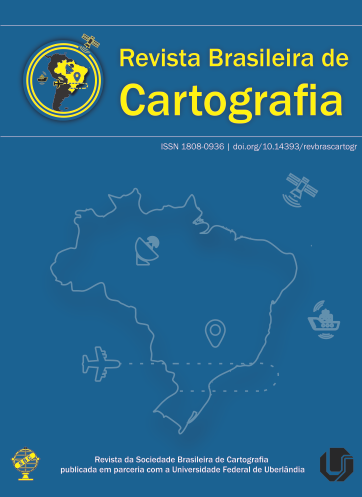Modelagem Dinâmica Espacial das Mudanças de Uso e Cobertura da Terra na Região Hidrográfica da Baía da Ilha Grande-RJ: um Enfoque Sobre Comunidades Tradicionais e Unidades de Conservação
Conteúdo do artigo principal
Resumo
O objetivo deste trabalho é analisar a influência das Unidades de Conservação (UCs) e das comunidades tradicionais no processo de mudança de uso e cobertura da terra na Baía da Ilha Grande ao longo dos anos de 2013 a 2018, por meio de modelagem dinâmica espacial. Para realizar a modelagem, foi utilizada a plataforma Dinamica EGO, que realiza simulação do uso e cobertura da terra com o método de pesos de evidência e é baseada no paradigma de autômatos celulares. Foi realizada a simulação espacial para doze unidades hidrológicas de planejamento, dando-se ênfase à observação das taxas de transição e aos pesos atribuídos para as variáveis de UCs e comunidades tradicionais. Nas UCs de Proteção Integral, foi observado um padrão de pesos negativos para as transições de desflorestamento e urbanização, ao passo que as UCs de Uso Sustentável indicam pressão antrópica sobre os ambientes naturais costeiros. As comunidades tradicionais apresentam dinâmicas próprias em seus territórios, sendo observado que os mesmos desfavorecem a urbanização no interior de seus limites. O modelo de Bayes foi capaz de simular os processos de mudança de uso e cobertura na área de estudo, e os resultados por ele produzidos podem ajudar na gestão da mesma. Os pesos atribuídos para as variáveis categóricas de UCs revelam como estas se comportam para determinadas transições, e as simulações por eles ajustadas produziram Índices de Similaridade Fuzzy satisfatórios. Este trabalho permitiu o entendimento das dinâmicas que ocorrem no interior de UCs e comunidades tradicionais, o que poderá auxiliar na elaboração de diretrizes para o planejamento territorial e ambiental.
Downloads
Detalhes do artigo
Seção

Esta obra está licenciado com uma Licença Creative Commons Attribution 3.0 Unported License.
Autores que publicam nesta revista concordam com os seguintes termos:
- Autores mantém os direitos autorais e concedem à revista o direito de primeira publicação, com o trabalho simultaneamente licenciado sob a Licença Creative Commons Atribuição que permite o compartilhamento do trabalho com reconhecimento da autoria e publicação inicial nesta revista.
- Autores têm autorização para assumir contratos adicionais separadamente, para distribuição não-exclusiva da versão do trabalho publicada nesta revista (ex.: publicar em repositório institucional ou como capítulo de livro), com reconhecimento de autoria e publicação inicial nesta revista.
- Autores têm permissão e são estimulados a publicar e distribuir seu trabalho online (ex.: em repositórios institucionais ou na sua página pessoal) a qualquer ponto antes ou durante o processo editorial, já que isso pode gerar alterações produtivas, bem como aumentar o impacto e a citação do trabalho publicado (veja "O Efeito do Acesso Aberto").





